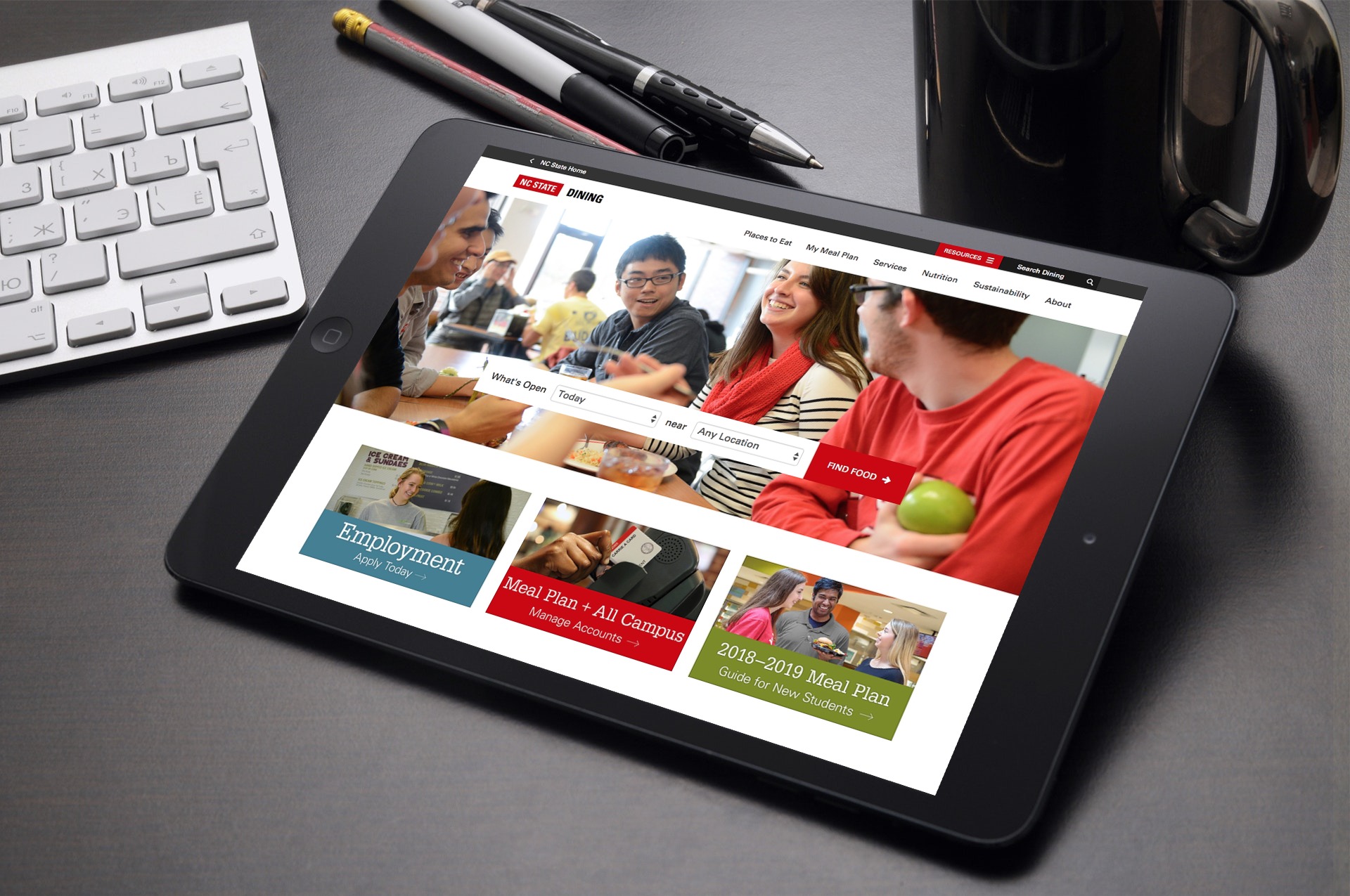Overview
On NC State’s campus, 17 restaurants, 11 cafes, six convenience stores and three large dining halls serve the school’s 34,000 students and another 9,000 faculty and staff. Over the years, NC State’s food service program has been recognized as one of the best of its kind in the United States. Among a lengthy list of accolades just in the past few years are its inclusion in Top 50 College Dining Experiences (College Rank, 2016), Top 10 Accommodating Gluten-Free Colleges (Udi’s Gluten Free, 2016) and the school’s designation in 2015 as the first institution in the nation to complete the Partnership for a Healthier America’s Healthier Campus Initiative.
However, despite the prominence of NC State’s on-campus dining options, the school’s Dining website was sorely out of date.
The new site needed to be better, to be on brand, to be more user-friendly, and to have all the nutritional information and menus and other information students needed – and all easily accessible. Of particular importance were accurate displays of the menus of the campus’ dining locations and information for students with food allergies or sensitivities.
The Challenge
The challenge was this: bring together the 37 on-campus dining locations, each with its own operating hours, menus, events and special services, and aggregate that information into a single website that would allow users to find critical information quickly and easily. In addition, students and staff needed clear guidance and access to information about the university’s meal plan options and what food options fit particular students’ specific nutritional needs.
Visually, the site needed to fit the existing digital brand established by NC State. From a functional standpoint, the site needed to be optimized for mobile use and to incorporate elements like mapping and point-to-point navigation and contact information. The existing site contained all the pertinent information – but redundancies, illogical data placement and navigational rabbit trails led to a user experience that was less than satisfactory.
An additional challenge existed: The legacy vendor’s previous design and the enormous volume of changing information being fed to the Dining website. Inside a data-driven site, delivering the critical information to the user necessitated creative problem-solving – a challenge compounded by the legacy vendor’s lack of cooperation in the process.
Initial Problems
The Verified Solution

Verified’s vision was to give the new NC State Dining site an “app” feel, similar to the experience of users of mobile applications such as OpenTable or Yelp. The end product would give students and faculty app-like search functions and functionality across a range of platforms. In the build process, Verified worked with NC State’s food service staff to streamline data to give users access to every piece of critical information – including hours of operation and location, menus, nutritional specifics, special events and services – inside a single site.
Verified Studios presented the idea for the website to function like an app, with user experience design at the forefront of our approach because students are used to these kinds of interfaces, and it makes the dining website much easier and more enjoyable to use, while still incorporating the crucial information required for such a site.
Our Process
Identify site constraints and shape the new site design and functionality around those constraints.
Utilize the information that exists on the site, organizing it such that the user can quickly and easily find the necessary information.
Design the site with brand and user experience in mind.
Create flexible database solutions that take into consideration issues with the legacy database while managing current challenges.
The Benefits
Of particular concern for NC State was building the new site in a way that suited the unique needs of students and faculty with dietary restrictions.
The new site design allows users to filter through all the dining options available at NC State and find the locations where they can safely eat and the dishes they can safely consume that have been prepared in such a way that they can be considered safe for them, and then also gives users access to the managers of those locations in case they wanted to ask more questions, follow up, see all the hours – and then being able to request special accommodations or have dialogue, if that was necessary.
The way the site was built before, users with dietary restrictions or food sensitivities might have go to multiple locations on the site to find critical information. Now they can just go into the search tool, say what their requirements are, filter everything they’re looking at through that requirement, go to the individual page, see the menu filtered by their requirement, and also have direct access to call or contact the manager of that establishment if they have additional questions – all without really having to do anything special other than let the site know they’re interested in filtering by that type of dietary restriction. The entire interface is shaped around that constraint.
On the front end, the new site visually displays the NC State brand. On the back end, the database is more functional.
The Future Opportunities
With this new website, the professionals at NC State Dining spend less time fielding the questions of frustrated diners and more time running the dining program. Our lengthy relationship with NC State shows how collaborative teamwork results in satisfying solutions.
As Allen Coin, NC State’s Web Strategist for University Communications said, “I felt like working with them was more like working with a team that I was a part of rather than working with just a vendor. The one thing I really appreciated is that they were very good about bringing their own personal expertise into the picture, to make recommendations… I appreciate the tendency of the Verified team to take an idea and say, ‘OK, how can we make that even better?’ I think that does lead to some really good results… I did have a large number of stakeholders, all of whom had their particular concerns about the web project, and I was able to use the feedback from the Verified team to try to mitigate those apprehensions. You make better decisions in a collaborative manner instead of just a top down manner.”

